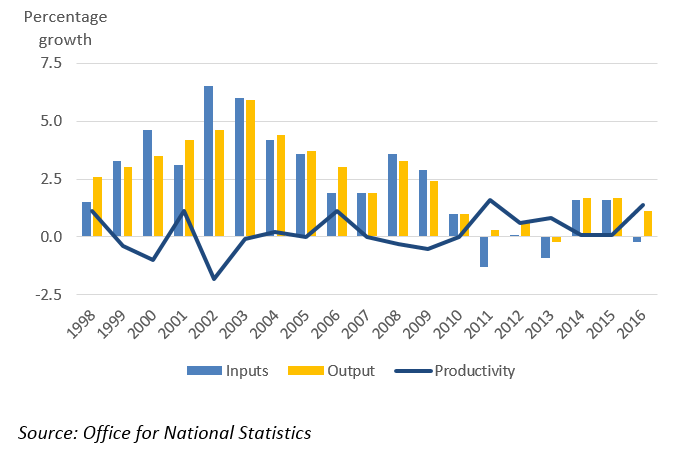The hardest part of productivity measurement

Productivity has been a topic of great interest in recent years, especially because of the well-known ‘productivity puzzle‘ – the historically weak productivity growth in the UK since the economic downturn in 2008.
But if that is a puzzle, here is another one – how do you measure the productivity of public services, like education or healthcare, when they are provided for free? Since 2005, ONS has developed suitable measures for over half of public services, but there is still much to do. In this blog Josh Martin explains how the ONS measures the productivity of public services.
As Economist Paul Krugman famously remarked “Productivity isn’t everything, but, in the long run, it is almost everything”. Improvements in productivity are generally considered the only sure-fire way to improve living standards in the long-run.
But usual productivity measures only really apply for the 80% of the economy that makes up the ‘market sector’, where businesses receive money (turnover) from selling their goods and services, making their ‘output’ easy to observe and their productivity relatively easy to measure.
Productivity of the public sector, by contrast, is much harder to measure. Since public services are not sold, it is much more difficult to decide how to measure output. But the public sector makes up about a fifth of the economy (by comparison, the manufacturing industry only accounts for around 10% of the economy), so it is vitally important to understanding the productivity of the UK economy as a whole.
A review by British economist Sir Tony Atkinson in 2005 kick-started better measurement of public service productivity. High among his recommendations were that we should account for the changing quality of public services. In most of the economy, a higher price reflects higher quality – hence the famous saying “you get what you pay for”. But with public services, there is no price, and cost might not be a good measure of quality either. New surgical techniques that reduce the risk of infection may cost little more, but could greatly improve patients’ survival chances, a critically important factor in the value of a procedure. Adjusting for the quality is one way of recognising improvements in public services (see our guide for more details).
In our headline annual estimates (the latest for 2016, see the chart below), we split public services into 9 core areas, of which healthcare and education are the largest. As it turns out, these are also the easiest to measure, since you can count the number of people interacting with these services. We also adjust for the quality of these services. For education for instance, we measure improvements in test scores, since teaching more children is no good if they all fail their exams. For healthcare, we use data on the number of operations and consultations, and various measures of quality relating to how successfully the service delivers improved health outcomes, such as survival rates and waiting times. Measuring the quantity and quality of the output is crucial.
Growth in public services inputs, output and productivity

Some other public services, such as defence, are ‘collectively provided’, which mean they aren’t provided to people directly. In these cases, we usually measure the output of the services by simply looking at how much it costs to deliver them, meaning that we cannot easily measure their productivity. We also have good measures of output and productivity, including quality adjustments, for adult social care and criminal justice, with less well-developed measures for police, fire services, children’s social care, and social security administration. A recent paper (and blog) by ONS experts charts the journey since the Atkinson Review – we have made much progress, but there is more still to be done.
Our public service productivity measures are complicated, and we get a lot of questions about how to understand them. They don’t say anything about value for money of what the government buys, or about whether the government is providing the right sorts of services that people want. The ONS recently launched the Efficiency Measurement Unit to address such broader questions in relation to public service provision.
Measuring public service productivity is always challenging, as policy changes frequently make our approaches outdated. The move to Universal Credit, changes to GCSEs, and the trend for devolution, all pose challenges to the way we measure public service productivity. We must work closely with the relevant government departments and public bodies to understand these changes and collect the right data to measure the productivity of public services. That often means looking at several different ways to measuring something and assessing which one works best.
As well as staying on top of policy changes, we are also working on the next set of improvements. Over the next year, we’ll be getting in touch with our counterparts in other countries to learn from their experiences and share our own. We are also working closely with a range of government departments in the UK to explain our methods, develop new approaches, and provide new and useful insights. We are publishing new guides on our statistics to help people understand and use them. We are even trying to measure the productivity of the ONS!
If you are interested in what we are doing, or would like to help, we’d love to hear from you – please contact productivity@ons.gov.uk.

Josh Martin is Head of Public Service Productivity at the ONS